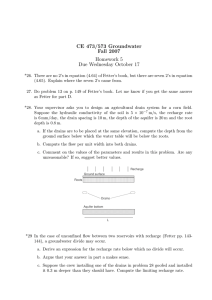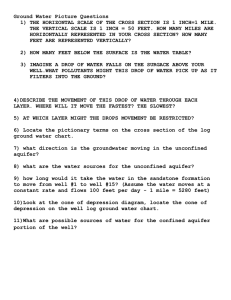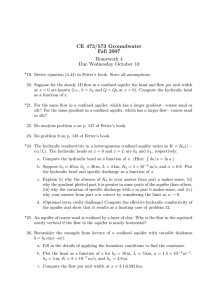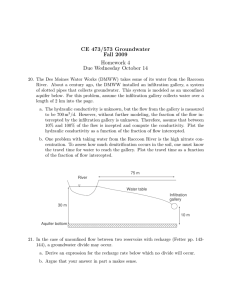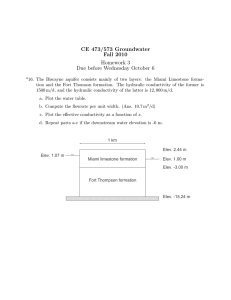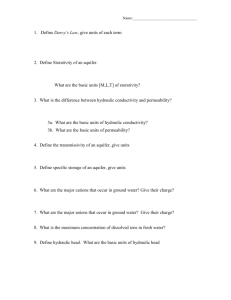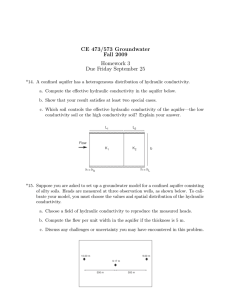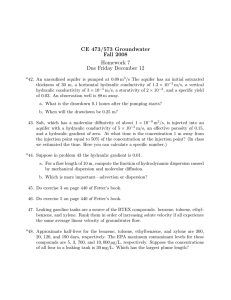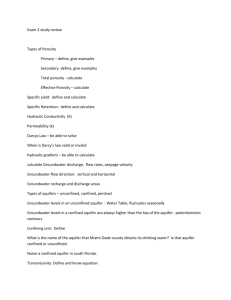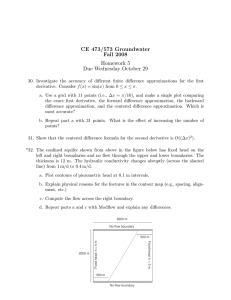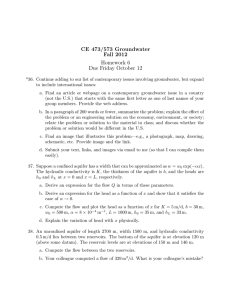CE 473/573 Groundwater Fall 2008 Homework 4 Due Friday October 17
advertisement
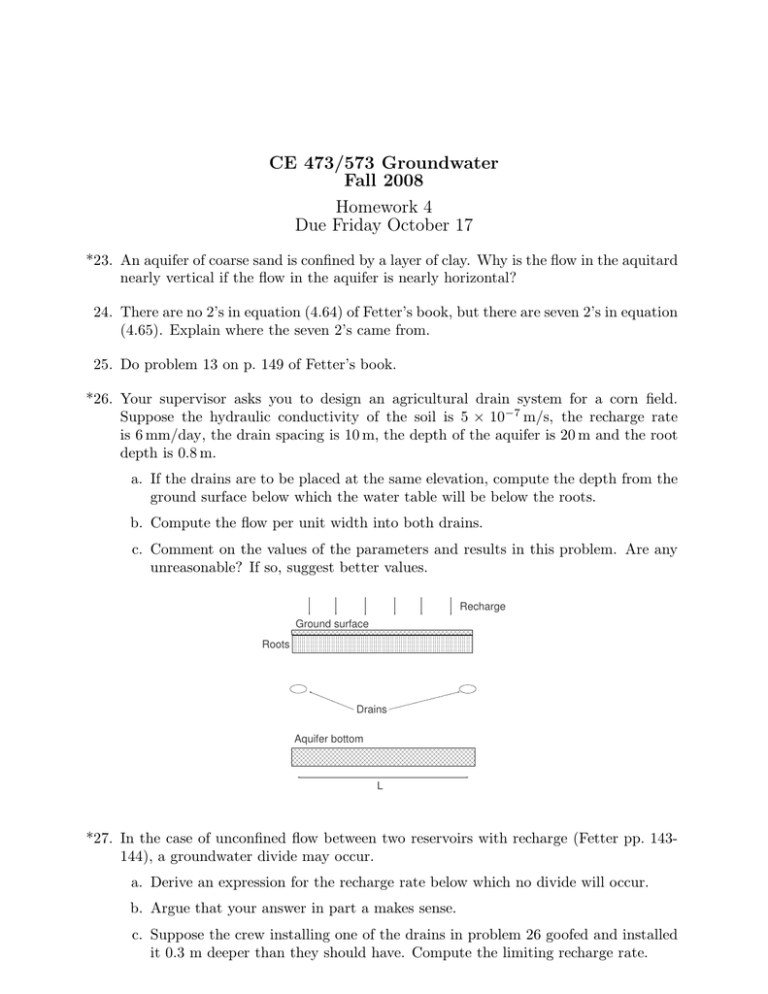
CE 473/573 Groundwater Fall 2008 Homework 4 Due Friday October 17 *23. An aquifer of coarse sand is confined by a layer of clay. Why is the flow in the aquitard nearly vertical if the flow in the aquifer is nearly horizontal? 24. There are no 2’s in equation (4.64) of Fetter’s book, but there are seven 2’s in equation (4.65). Explain where the seven 2’s came from. 25. Do problem 13 on p. 149 of Fetter’s book. *26. Your supervisor asks you to design an agricultural drain system for a corn field. Suppose the hydraulic conductivity of the soil is 5 × 10−7 m/s, the recharge rate is 6 mm/day, the drain spacing is 10 m, the depth of the aquifer is 20 m and the root depth is 0.8 m. a. If the drains are to be placed at the same elevation, compute the depth from the ground surface below which the water table will be below the roots. b. Compute the flow per unit width into both drains. c. Comment on the values of the parameters and results in this problem. Are any unreasonable? If so, suggest better values. Recharge Ground surface xxxxxxxxxxxxxxxxxxxxxxxxxxxxxxxxxxxxxxxxxxxx xxxxxxxxxxxxxxxxxxxxxxxxxxxxxxxxxxxxxxxxxxxxxxxxxxxxxxxxxxxxxxxxxxxxxxxxxxxxxxxxxxxxxx xxxxxxxxxxxxxxxxxxxxxxxxxxxxxxxxxxxxxxxxxxxx xxxxxxxxxxxxxxxxxxxxxxxxxxxxxxxxxxxxxxxxxxxxxxxxxxxxxxxxxxxxxxxxxxxxxxxxxxxxxxxxxxxxxx xxxxxxxxxxxxxxxxxxxxxxxxxxxxxxxxxxxxxxxxxxxxxxxxxxxxxxxxxxxxxxxxxxxxxxxxxxxxxxxxxxxxxx xxxxxxxxxxxxxxxxxxxxxxxxxxxxxxxxxxxxxxxxxxxxxxxxxxxxxxxxxxxxxxxxxxxxxxxxxxxxxxxxxxxxxx Roots xxxxxxxxxxxxxxxxxxxxxxxxxxxxxxxxxxxxxxxxxxxxxxxxxxxxxxxxxxxxxxxxxxxxxxxxxxxxxxxxxxxxxx xxxxxxxxxxxxxxxxxxxxxxxxxxxxxxxxxxxxxxxxxxxxxxxxxxxxxxxxxxxxxxxxxxxxxxxxxxxxxxxxxxxxxx xxxxxxxxxxxxxxxxxxxxxxxxxxxxxxxxxxxxxxxxxxxxxxxxxxxxxxxxxxxxxxxxxxxxxxxxxxxxxxxxxxxxxx xxxxxxxxxxxxxxxxxxxxxxxxxxxxxxxxxxxxxxxxxxxxxxxxxxxxxxxxxxxxxxxxxxxxxxxxxxxxxxxxxxxxxx xxxxxxxxxxxxxxxxxxxxxxxxxxxxxxxxxxxxxxxxxxxxxxxxxxxxxxxxxxxxxxxxxxxxxxxxxxxxxxxxxxxxxx xxxxxxxxxxxxxxxxxxxxx xxxxxxxxxxxxxxxxxxxxx xxxxxxxxxxxxxxxxxxxxx xxxxxxxxxxxxxxxxxxxxx xxxxxxxxxxxxxxxxxxxxx xxxxxxxxxxxxxxxxxxxxx xxxxxxxxxxxxxxxxxxxxx xxxxxxxxxxxxxxxxxxxxx xxxxxxxxxxxxxxxxxxxxx Drains xxxxxxxxxxxxxxxxxxxxxxxxxxxxxxxxx xxxxxxxxxxxxxxxxxxxxxxxxxxxxxxxxx xxxxxxxxxxxxxxxxxxxxxxxxxxxxxxxxx xxxxxxxxxxxxxxxxxxxxxxxxxxxxxxxxx xxxxxxxxxxxxxxxxxxxxxxxxxxxxxxxxx xxxxxxxxxxxxxxxxxxxxxxxxxxxxxxxxx xxxxxxxxxxxxxxxxxxxxxxxxxxxxxxxxx xxxxxxxxxxxxxxxxxxxxxxxxxxxxxxxxx xxxxxxxxxxxxxxxxxxxxxxxxxxxxxxxxx Aquifer bottom xxxxxxxxxxxxxxxxxxxxxxxxxxxxxxxxxxxxxxxxxxxxx xxxxxxxxxxxxxxxxxxxxxxxxxxxxxxxxxxxxxxxxxxxxx xxxxxxxxxxxxxxxxxxxxxxxxxxxxxxxxxxxxxxxxxxxxx xxxxxxxxxxxxxxxxxxxxxxxxxxxxxxxxxxxxxxxxxxxxx xxxxxxxxxxxxxxxxxxxxxxxxxxxxxxxxxxxxxxxxxxxxx xxxxxxxxxxxxxxxxxxxxxxxxxxxxxxxxxxxxxxxxxxxxxxxxxxxxxxxxxxxxxxxxxxxxxxxxxxxxxxxxx L *27. In the case of unconfined flow between two reservoirs with recharge (Fetter pp. 143144), a groundwater divide may occur. a. Derive an expression for the recharge rate below which no divide will occur. b. Argue that your answer in part a makes sense. c. Suppose the crew installing one of the drains in problem 26 goofed and installed it 0.3 m deeper than they should have. Compute the limiting recharge rate. *28. The Biscayne aquifer consists mainly of two layers: the Miami Limestone formation and the Fort Thomson formation. The hydraulic conductivity of the former is 1500 m/d, and the hydraulic conductivity of the latter is 12, 000 m/d. a. Plot the water table. b. Compute the flowrate per unit width. (Ans. 2.9 m2 /d) c. Plot the effective conductivity as a function of x. d. Suppose the downstream water level is below the top of the Fort Thompson formation. Outline how you would find the water table in this case (but do not actually do it.) In particular, explain why this problem is more difficult than that for parts (a)-(c). 1 km Elev. 2.44 m Elev. 1.07 m Miami limestone formation Elev. 1.00 m Elev. -3.00 m Fort Thompson formation xxxxxxxxxxxxxxxxxxxxxxxxxxxxxxxxxxxxxxxxxxxxxxxxxxxxxxxx xxxxxxxxxxxxxxxxxxxxxxxxxxxxxxxxxxxxxxxxxxxxxxxxxxxxxxxx xxxxxxxxxxxxxxxxxxxxxxxxxxxxxxxxxxxxxxxxxxxxxxxxxxxxxxxx Elev. -15.24 m *29. A confined aquifer of thickness 10 m, storativity 0.005, and hydraulic conductivity 3 × 10−5 m/s has an initial head of 20 m. The confining layer is leaky; its thickness is 2 m, and its hydraulic conductivity is 4 × 10−7 m/s. Somehow the unconfined aquifer above the confining layer is flooded so that the water table has a head (based on the same datum as the confined aquifer) of 30 m. a. Compute the time required for the difference in heads between the confined and unconfined aquifer to reach 1% of the initial value. b. Re-compute the time if the storativity is 0.0025. c. Explain why the time changed from part a to part b.
